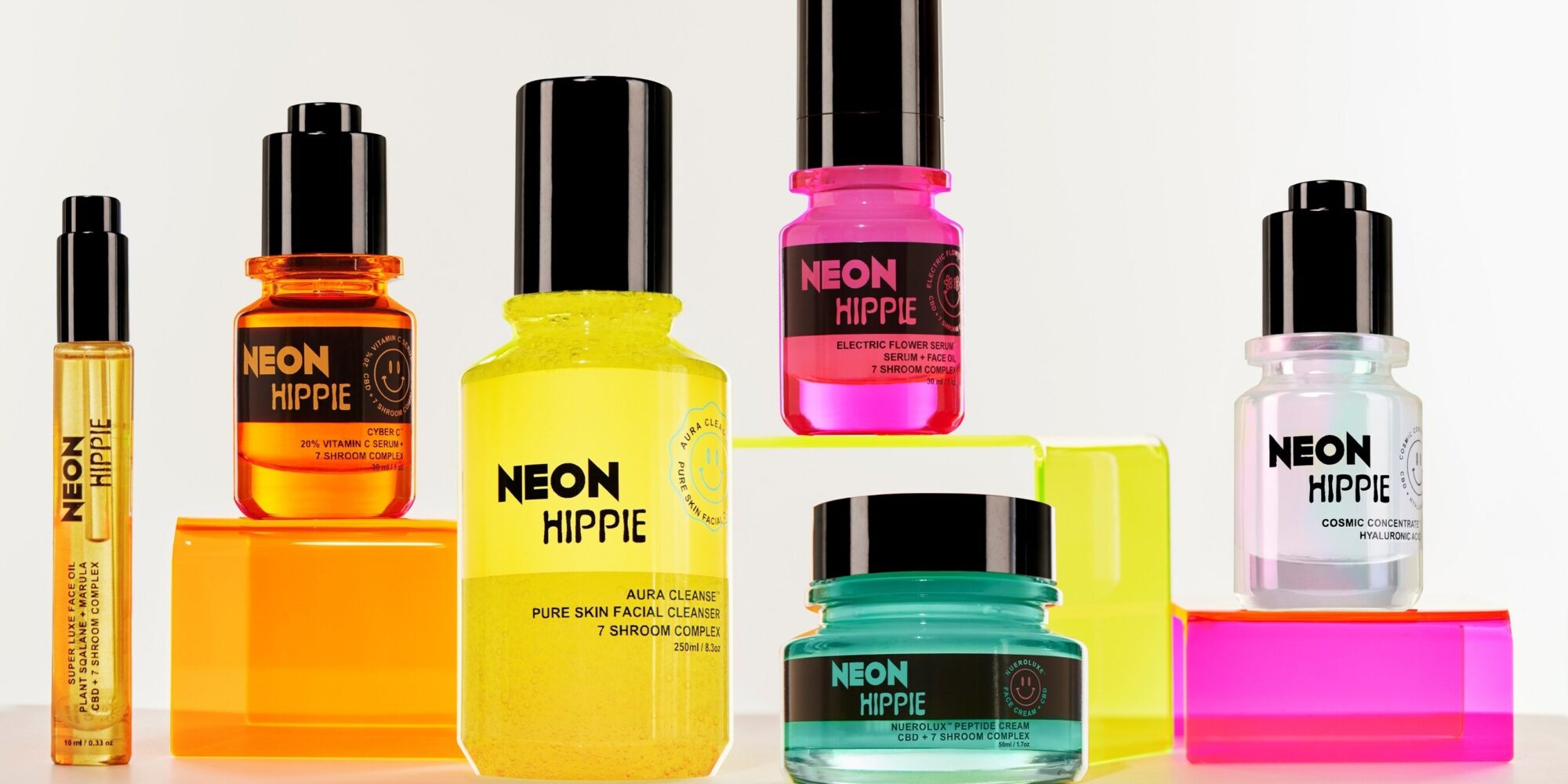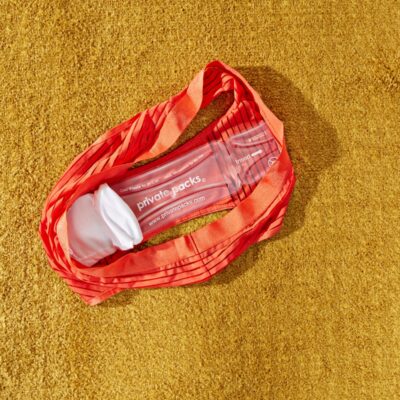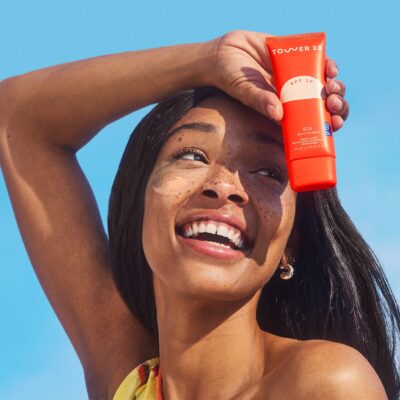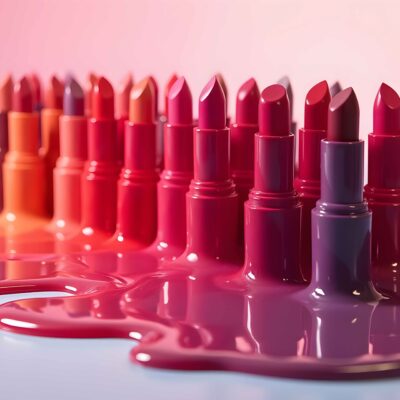
Realistic First-Year Sales Expectations For Indie Beauty Brands
In its coverage of Neon Hippie, the publication Women’s Wear Daily reported the new mushroom-powered brand forecasts it could reach $40 million in first-year sales. The brand, which has seven products priced from $25 to $125, including Super Luxe Face Oil, Cosmic Concentrate, Aura Cleanse, Neurolux Peptide Cream and Electric Flower Serum, has experienced leaders to guide growth and nailed down Neiman Marcus as a launch partner.
Nicole Ostoya, who’s had a long history in the beauty industry with stops at Nordstrom, Benefit Cosmetics, ShopHQ and Boldface, a branding company that had an ill-fated partnership with the Kardashians, founded Neon Hippie and turned to Florence Nacino, CEO of V Manufacturing & Logistics, to create its formulas. Along with Neiman Marcus, Ostoya told Beauty Independent that the brand has “overseas markets already in the works” to drive revenues.
If Neon Hippie reaches $40 million in first-year sales, it will be among a rarified group of nascent beauty brands. Its ambitions to be in that group got us thinking about the sales most beauty brands achieve during their initial year in business.
To gain a better understanding of that figure, for our ongoing series posing questions relevant to indie beauty, we asked 16 beauty entrepreneurs, investors and consultants the following questions: What’s a realistic first-year sales expectation for indie beauty brands? Do you think first-year sales expectations should change in the current market?
- Elizabeth Lim Strategic Advisor and Consultant, Elizabeth Lim Strategy & Consulting
After reviewing Neon Hippie more closely, with its nine stockkeeping units and what looks to be international availability, $40 million in first-year sales may be ambitious, but not impossible if they also plan to open retail globally and launch additional SKUs plus have a robust marketing plan within the first year.
First-year sales expectations can really vary, from a couple of thousand dollars to millions for an indie beauty brand as it isn't one size fits all and is based on several key factors, including the following:
- SKU Count: More products can yield higher basket size.
- Suggested Retail Price: A higher price item could command a higher average order value (AOV). Conversely, lower price items could have mass appeal and result in higher volume
- Omnichannel Approach: Retail partners, Amazon and/or TV shopping can contribute to first-year sales
- Global Distribution: Multiple countries launching at the same time could prove to be beneficial in the first year.
- Marketing Support: A robust budget to not only tell a unique brand story and positioning (paid, owned, earned), but also support each initiative (retail support, merchandising, global expansion, etc.) will be paramount to achieving sales goals.
With all of this coupled with a strong team and solid operating ecosystem from supply chain to fulfillment, anything is possible. It is really important that any beauty brand set themselves up for success by building an appropriate business model and strategic roadmap that leads to sustainable growth.
- Patricia Valera Founder, Beautybrandr
In order to launch with such a strong portfolio of products and these huge goals, Neon Hippie is clearly backed by serious funding. I imagine they're spending upwards of $2 million on marketing, advertising and PR alone, not including production and operations.
It's nearly impossible for the vast majority of indie startups to launch at this level as they are usually bootstrapped, so it's not a fair comparison. For most of my clients, achieving $100,000 in their first year would be fantastic. A more realistic first-year revenue goal for a modestly funded startup beauty brand is somewhere in the vicinity of $500,000.
With regards to the economy, launching a beauty brand is challenging in any economy. The changes I recommend for a go-to-market strategy nowadays have less to do with the economy and more to do with the oversaturation of beauty brands in social media.
It has become exceedingly expensive and difficult to find and connect with customers, let alone retain their attention long enough for them to buy. I see more and more brands finding success by returning to some traditional marketing practices: direct mail, billboards, consumer events, trunk shows, etc.
Additionally, it's important to remember that large chain retailers like Sephora, Ulta and Target are not the be all, end all. There are thousands of boutique retailers locally and nationally where brands can start and grow—and they are so much easier to get into.
- Tina Bou-Saba Co-Founder and Co-Managing Partner, Verity Venture Partners
I think that first-year sales expectations for indie beauty brands can vary dramatically. Factors impacting this include bootstrapped versus investor-backed, product category, channel strategy, existing audience (for example, an influencer founder), price points and number of SKUs.
For example, a bootstrapped indie brand selling one to two SKUs DTC-only and no influencer founder will look very different in the first year from an investor-backed brand with a influencer at the helm and a broad assortment.
The latter could indeed achieve millions of dollars in year one sales. On the other hand, the former might achieve just $100,000 of sales or perhaps more generally $100,000 to $1 million or so. I’d say that’s a reasonable range for a more “typical” indie brand that has not raised significant outside capital, and thus can’t spend heavily on marketing.
With respect to the current market, I think that it’s become much more challenging for indie brands to grow without major marketing spend. This is driven by saturation across consumer categories, iOS 14-related privacy changes and crowded digital marketing channels/ prohibitively high CAC (customer acquisition costs).
Gone are the days when a new brand could efficiently acquire customers online and get quick scale. Today, it’s harder than ever to get to $1 million in sales.
- Odile Roujol Founding Partner, Fab Co-Creation Studio Ventures
First-year sales expectations for indie beauty brands can be between $250,000 to $1 million if they are pure direct-to-consumer. It's always easier when having built a community before with advocates of the brand and experts prescribing it.
I never recommend to founders that their company jumps to retailer partnerships before having insights (Who are the customers? Why do they like the brand? Do they have the feeling they belong?) and metrics, including average order, repurchase after three months and retention rate after one year.
It’s more the path of growth and profitability that I look at rather than rushing to make a big year. Know your customers first, improve products and the experience, then scale.
- Melody Bockelman Founder, Private Label Insider
Beauty is a stable industry to be in, and even with the current economic forecast, we are expected to grow in 2023. For most indie beauty brands, they can expect to make six figures in their first year.
However, if you have had prior experience in entrepreneurship, access to capital and background in digital marketing, you can easily exceed this amount. This is the exception, though.
For most startup entrepreneurs, the initial twelve months is dedicated to creating their brand, enhancing their product, crafting their identity and launching. Year two is all about building a solid foundation that includes an email list, fan base, influencer partnerships and ads, and discovering how to maintain a steady marketing process.
The third year is all about growth. This is when they have established a sizable email list and following and are ready to scale to millions.
- Margarita Arriagada Founder, Valdé Beauty
A realistic first year sales expectation for an indie beauty brand is dependent on the amount of investment being made to launch for awareness/marketing and if the brand has plans to launch with a retail partner.
If the brand is bootstrapping and mainly direct-to-consumer, sales most likely will be under $1 million. If there's some level of investment, $500,000 to $750,000 for example, it's possible to generate $1 million to $3 million.
With a retail partnership, it's possible to get to a higher number. Given current conditions, it is prudent to plan more conservatively and stay as scrappy as possible.
- Rose Fernandez Beauty Industry Expert and Advisor
An indie brand with a direct-to-consumer business of a couple of million dollars and a solid community base and repurchase rate that launches into retail with a meaningful number of doors and dot-com should expect to generate somewhere between $8 million to $12 million retail in the first year, and then have high double-digit growth in the following year.
Some would say the brand could double in sales, but strong growth is realistic. This is with the expectation of several factors: retailer partnership/support, marketing investment, product pipeline and, of course, differentiation is critical.
Most retailers will expect that there is a consumer base to drive awareness and ultimately sales. While the retailer certainly helps build this, the onus is on the brand.
Even in today’s current market, the expectations should remain as consumers more than ever are highly engaged, highly educated on brand/product credibility and efficacy, giving opportunity for brands that do all of these things well to own share of business. The more dialed in the brand, the better the sales.
- Julie Garza Founder, Belleza Brand Blueprints
I've seen indie brands just starting out generate $5 million in year one and others who have generated $30 million-plus. First-year sales can vary greatly based on the category, your unique points of difference (POD), your assortment, your marketing plan and your distribution strategy.
If you truly want to scale quickly and generate healthy revenues, then you must establish a healthy mix of distribution. For example, you may lean into a smaller luxury department store partner with a smaller door count for positioning.
However, in order to generate large revenue targets out the gate, you must land distribution with a retailer who has a significant door count, broad reach and space for storytelling. It is difficult to launch with a smaller retailer and expect them to do all the heavy lifting for revenue generation. Door count and space equal dollars.
Some of the challenges indie brands face when launching in retail are understanding forecasting, inventory requirements, retailer weeks of supply (WOS), turn, and the fact that it takes a couple of months to establish a measurable trend, therefore, sometimes underdelivering and overestimating sales expectations.
I believe that consumers will adapt their budgets to inflation and become more cautious when spending. However, their need for self-care is strong as we recover from the pandemic and face the exorbitant costs of living, environmental challenges and political turmoil. Consumers have the desire to connect to meaningful things causing intentional spending on things that make them feel good. Beauty is just that!
- Brooke Young Beauty Brand Developer and Owner, Vegan Luxe Esthetics
As the owner of Houston’s first and only 100% vegan spa experience, Vegan Luxe Esthetics, I understand what taking a risk looks like. Does that mean success is unlikely? Of course not.
However, no matter how big the dream, the reality is that indie beauty brands can hope for up to $1 million in first-year sales upon a sizable investment and top-tier brand awareness campaigns in the space.
For Neon Hippie, launching solely in one retailer, who recently announced steering their marketing efforts to focus on a marginal sector of their client base, is going to weigh heavily on their year-one revenue. A projected $40 million could prove to be an unattainable goal.
- Rohit Banota Founder, Jump Accelerator
It is possible, but highly improbable for an indie beauty brand to do $40 million in sales in the first year. After all, Fenty crossed $500 million within the first 12 months of launch, but Rihanna is a celebrity with mass awareness.
If the founder has the below four assets, it can happen:
- Validation for consumer acquisition and loyalty numbers, and funds to scale.
- Validation for advocacy, meaning the brand will potentially go viral because of the happy ingredients. If the skin feels happy, that’s communicated to the brain. This will ensure demand. How much of that demand can be met with purchase drivers such as availability also needs to be factored in, a good problem to have.
- An exclusive partnership with a retailer of scale, and the retailer is committed to the brand’s success.
- An exclusive partnership with a celebrity who has mass appeal with around 50 million to 100 million social media followers—that’s an estimate based on the social media following of leading celebrity beauty brands—plus brand fit.
Most non-celebrity indie beauty brands that get to $100 million in three to four years do approximately $1 million in the first year or a little more, and they usually have funding.
The first year is about finding product-market fit unless the testing has revealed outrageous reviews, and there is already a validation for product-market fit.
At Neon Hippie, the founder is a beauty veteran with an R&D pro by her side. That tells me that she must know what she is doing and have some validation. They must sort out more than a few kinks when the mushroom hits the skin.
- Andrew Ross Senior Advisor and Venture Partner, XRC Labs
Setting and evaluating first-year sales expectations depends on the brand's positioning, assortment architecture, pricing and, above all, on initial distribution strategy.
Instead of just focusing on top-line headlines, brands and investors should look at a combination of metrics that balance performance and sustainable health: sell-through (not just sell-in), velocity per door, customer acquisition cost (CAC) and direct-to-consumer return metrics, repeat rate and gross contribution.
Ask what it means to launch strong and stay strong, one of my favorite Leonard Lauder questions. Unsustainable growth will not be rewarded in today's market, that is the epitome of a zero-interest rate phenomenon.
- Karen Young Founder, The Young Group
It’s impossible to predict first-year sales for a new brand as there are so many variables such as:
- Number of SKUs
- Distribution channels (Can retail partners help with the model based on other brands they've stocked? In brick-and-mortar retailer, is the retailer providing support, including marketing, advertising, events, etc.?)
- Price point
- Marketing budget, especially for social media, influencers, advertising, pop-ups and sampling
- Ability to leverage the founder for social media, press and history
- Press or awards
Based on my history with indie brands, I make them start at rock bottom to keep expectations low. I ask them, "Imagine you'll sell two pieces per week, what does that look like?"
Unless there's significant brand awareness or a famous founder, given the competition, don't expect any sales of consequence in the first couple of years.
- Lydia Lovig Principal Consultant, Lydia Charlotte International
There’s really two ways of answering this question: For brands who have already launched, and brands who have not yet launched. There’s also one more important caveat: Remember that this is a raw sales expectation question, not a profitability question.
For most small, independent beauty brands who have already launched, ask yourself: What did you invest in the brand to start it, from formulation to creative assets to website to social media to influencers hired to promote the brand to events, etc.? The caveat is this is not to be confused with the dollars you spent in sitting inventory.
Whatever this dollar number is, this is the number on the board to aim for in year one. Even with a major wholesale partner and the associated opening purchase order, the resources required to support that partner will put you at net neutral.
Even in the most crowded beauty categories, there’s always room for someone new and differentiated, someone with a unique voice and perspective. Beauty has a gravitational pull, attracting creatives and energetic entrepreneurs. Agencies and manufacturers of all types have recognized this and made the path to beauty brand creation simpler—and less costly—than ever.
There is a big difference, however, between beauty brand creation and selling product. Neon Hippie’s founder has been in the product development space for over 10 years. She’s seen brands succeed and fail, and has seen the secret sauce in action many times.
For those who haven’t watched this story play out over and over like beauty Groundhog Day, these are my loudest pleas to beauty brand founders and teams. In order to connect with an increasingly inaccessible customer (barraged as she is by ads, crowded and ever-changing shelves, TikToks with mixed directives, etc.) brands find themselves in a budget war for attention. Who can have the best packaging? The best creative? The best ads? The best events?
If you’re in a position where you want to start your brand, but you have not yet launched, invest in:
- Genuine community identification, and create for that community.
- A "thumb-stopping” thumbprint or an aesthetic unmistakably and unabashedly yours, one that differentiates you immediately from those next to you, whether on shelf or online.
- Get a merchant or ex-merchant’s perspective on the brand assortment in early days before you go to print on packaging.
- There are strategic investments you can make that can 3X, 6X, 10X your year one and two.
- Lisa McCaffrey Founder and Creative Director, Kisscut Creative
Predicting the first-year of sales for an indie beauty brand is challenging. However it’s an important step in the planning process that can make or break a business.
As first-year sales will depend on factors such as beauty segment, cost of goods sold, margins, channel strategy and marketing, it can vary widely. Reaching millions within the first year is ambitious without the right partners, tools and funding.
This is where clarity around the vision and goals of the company and a strategic plan to achieve those objectives is important. Aside from having an amazing product that solves a problem, being able to differentiate through storytelling and the overall customer experience is imperative.
I’ve seen incredibly smart people invest their funds into product development without planning and setting aside a realistic marketing budget. They have a brilliant product and little means to communicate its existence to the world. There’s a saying that, “Without a plan, you are planning to fail.”
- Vicky Colangelo Beauty and Wellness Industry Consultant, Nxt Beauty
This year we are finding ourselves planning for another turbulent year. Consumers are adapting their budgets to inflation and the looming recession by emphasizing value and being more conservative with spending.
I remain optimistic, but would be conservative with a first-year sales forecast. Better to overdeliver than to overpromise.
Forecasting is an art and science, leaning more on the art side year one because you don’t have history. I have seen and experienced first-year sales from the thousands to the hundreds of thousands to the millions.
A brand can attain quicker sales if they already have a community built. I have seen influencer brand sales reach millions year one, but, as we have seen, that is not always the case.
Other contributing factors are having patent ingredients with proven science and claims, multiple points of distribution, preferably with more than one retailer, having a hero product that has a high repeat and being in a high growth or emerging category.
- Cristina Nuñez Co-Founder and General Partner, True Beauty Ventures
Estimating an indie beauty brand’s first-year sales can be as scientific as putting your finger in the air. As a beauty- and wellness-focused fund, we have seen almost 1,500 brands since True Beauty Ventures launched in 2020. Many have shown us a wild range of first-year sales forecasts, and what most of them have in common is that they were inevitably wrong. It rarely ever goes according to plan, to the positive or the negative.
Building a brand, awareness, product and community is incredibly difficult. Even if you are a big celebrity or influencer brand who arguably has a confirmed built-in audience, it still could not work. Realistically, even new brands that are launching with all-door distribution in Sephora or Ulta will not achieve meteoric growth in year one.
Beauty brands require significant working capital investment and are not as capital-efficient when they lack scale. In today’s environment, where investors are a bit more hesitant and discerning, I believe it is more important to demonstrate a viable business model with realistic growth expectations—e.g., $1 million to $3 million in first-year sales—and a clear path to profitability.
If you have a question you’d like Beauty Independent to ask beauty entrepreneurs, executives, consultants and investors, please send it to editor@beautyindependent.com.






Leave a Reply
You must be logged in to post a comment.